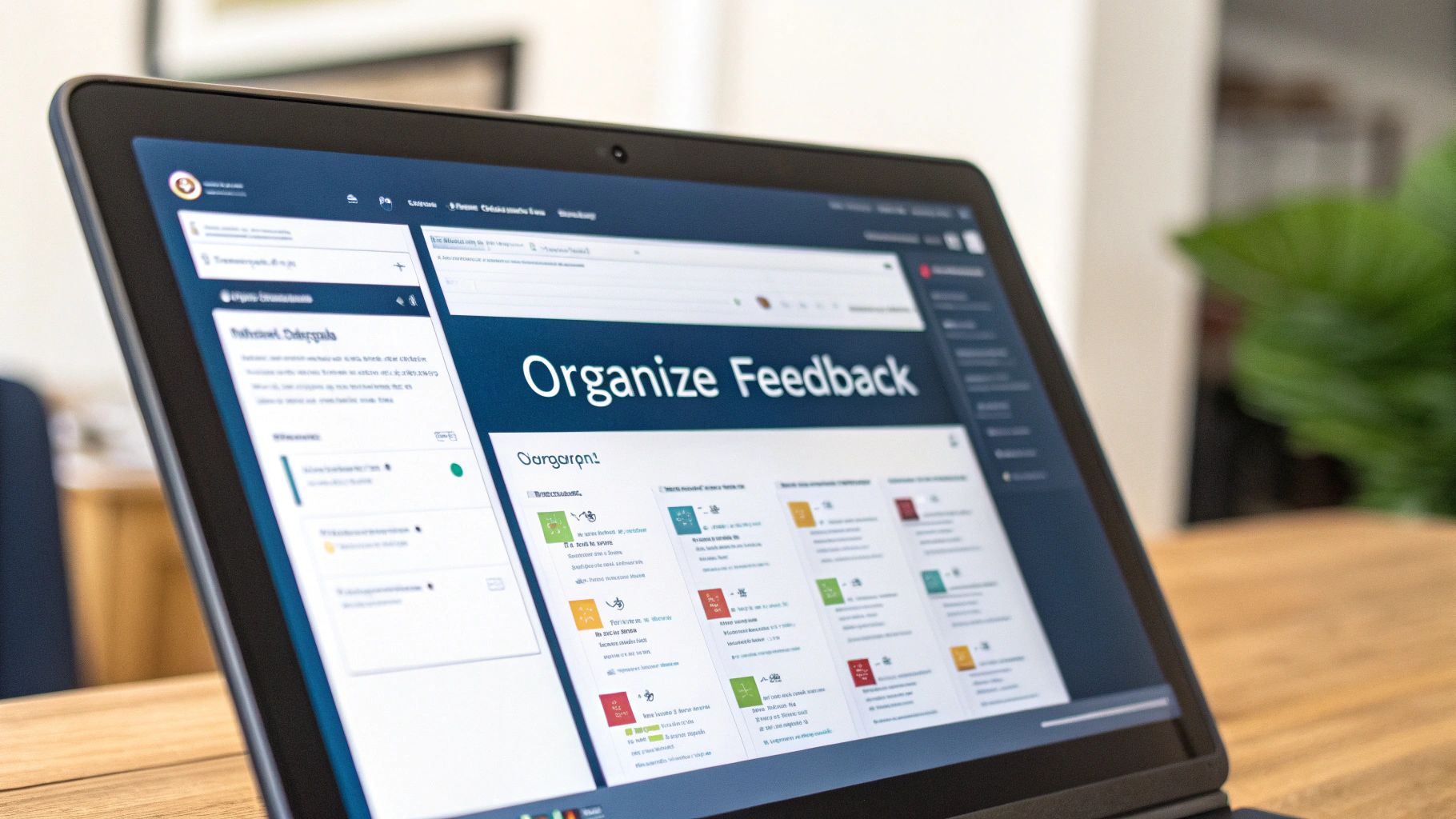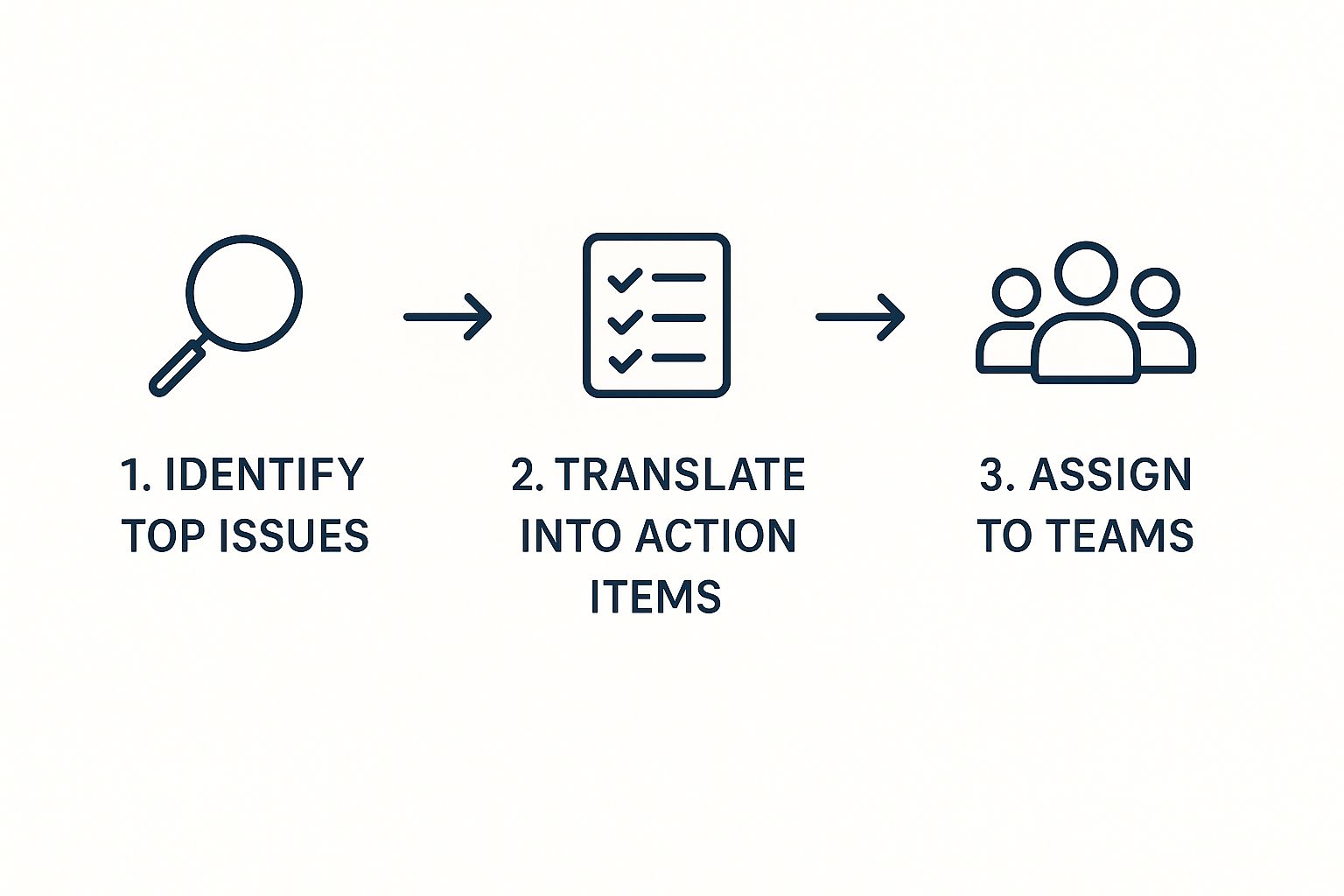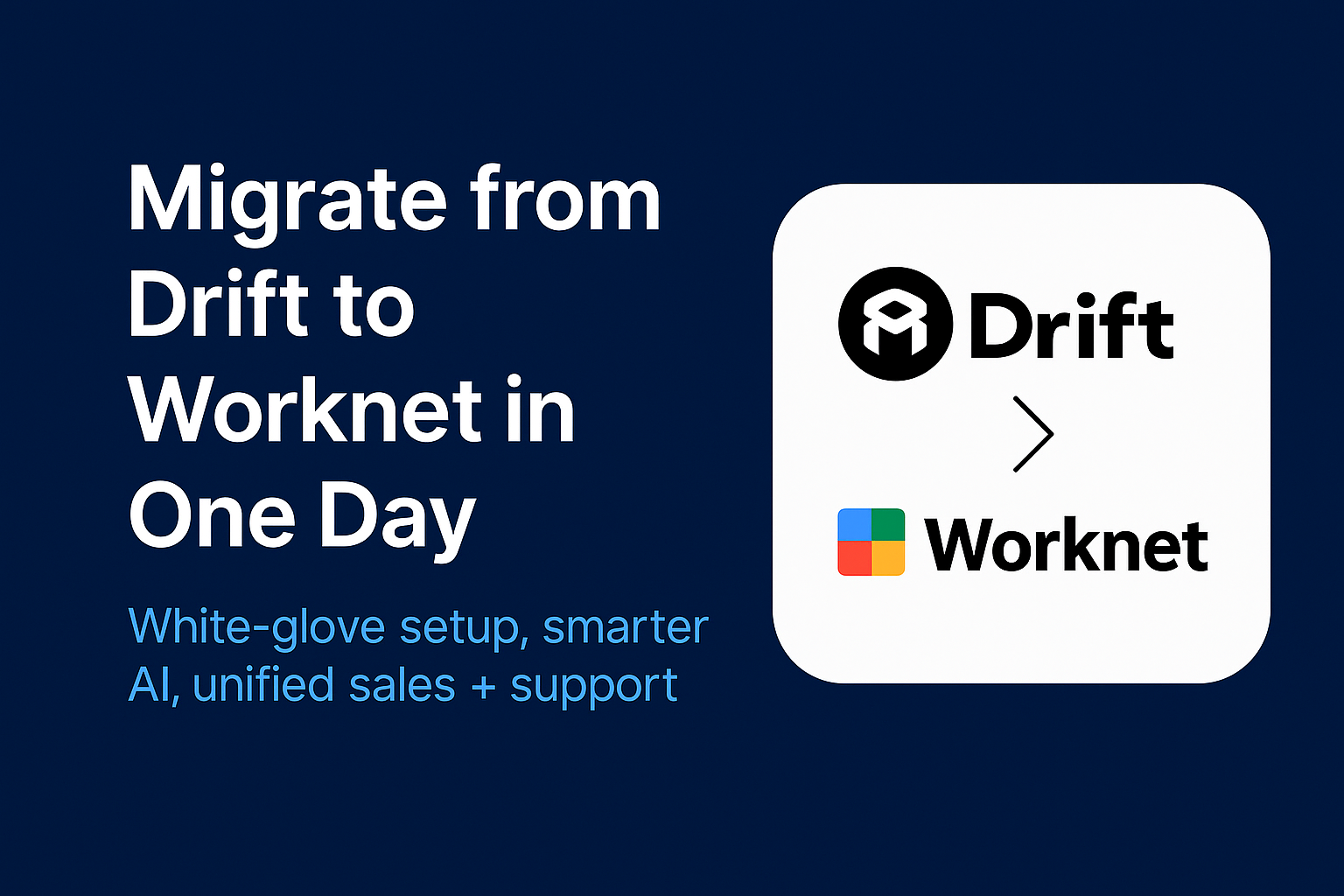A Practical Guide to Analyzing Customer Feedback for Business Growth
Analyzing customer feedback is the systematic process of reviewing customer opinions to uncover actionable insights. This isn't a "nice-to-have" task for a slow afternoon; it's a core business function that directly impacts your bottom line. Even small adjustments based on what customers tell you can be the difference between a customer who stays loyal and one who leaves for a competitor. This guide will walk you through building a process for analyzing customer feedback to drive real growth.
Why Analyzing Customer Feedback Is a Non-Negotiable Strategy

In any competitive market, simply assuming you know what your customers want is a high-stakes gamble. The reality is, your customers are constantly sending signals about their experience through support tickets, reviews, survey responses, and social media comments.
Ignoring this stream of information isn't just a missed opportunity—it's a critical business risk that can lead to stalled growth and a decline in the customer loyalty you've worked so hard to build.
The good news? That same stream of information is a goldmine of strategic intelligence. When you start methodically analyzing customer feedback, you move beyond gut feelings and begin making data-informed decisions that truly resonate with the people who keep your business running.
The Real-World Impact of Listening
Consider this common scenario: a subscription box company notices a small but consistent increase in cancellations over a single quarter. On the surface, everything seems fine—the product is good and marketing is hitting its targets. So, what's wrong?
It wasn't until they started digging into their cancellation survey comments that a clear pattern emerged.
A surprising number of people mentioned how frustrating it was to update their shipping address. A minor flaw in the user interface, buried deep in the account settings, was making the process a headache. This small point of friction was enough to convince otherwise happy customers to cancel. By identifying and fixing that one issue, the company stopped the churn, demonstrating a direct and immediate ROI from simply paying attention.
Key Takeaway: The most impactful improvements often don't come from massive, expensive overhauls. They come from fixing the small, persistent annoyances your customers are already telling you about.
To get started, it's helpful to understand the basic pillars of a solid analysis process. It’s all about turning raw comments into clear, strategic intelligence.
Core Components of Customer Feedback Analysis
Having this framework in place ensures you're not just collecting data for the sake of it, but are actively using it to make smarter business decisions.
A Widespread Decline in Customer Experience
This proactive approach is more critical now than ever. According to the 2025 Global Customer Experience Index from Forrester, a shocking 21% of brands saw their CX scores drop, while only 6% improved.
This trend underscores the urgency for companies to rigorously analyze and act on feedback. When the bar is getting lower across the board, even minor improvements can have an outsized impact on retaining customers and growing revenue.
Ultimately, analyzing feedback is about closing the gap between the experience you think you provide and the one your customers actually have. It's the foundation for building a product that people don't just use, but one they love and recommend. As you build this muscle, you'll naturally discover countless ways to improve customer satisfaction across their entire journey with you.
Building Your Feedback Collection System

Before you can analyze customer feedback, you need a smart way to collect it. The quality of your insights is directly tied to the quality of your data. This isn't about casting the widest net possible; it's about being intentional.
Too many businesses try to be everywhere at once, spreading their efforts thin. A better approach is to pinpoint where your customers are already talking and focus your energy there. The goal isn't just to get feedback, but to get the right kind of feedback that helps you make better decisions.
Choosing Your Primary Channels
Think about where it makes the most sense for your customers to give you their thoughts. An e-commerce brand, for instance, will strike gold with post-purchase email surveys and on-site product reviews. These channels capture immediate reactions to the product and the buying experience, which is exactly what they need.
In contrast, a B2B SaaS company should look in different places. For them, the most valuable feedback often comes from:
- In-app feedback widgets: Perfect for capturing user thoughts in the moment, whether it's an idea for a new feature or frustration over a bug. The context is built-in.
- Support ticket analysis: Your customer support desk is a treasure trove of data. Analyzing these conversations reveals recurring problems and friction points that might otherwise go unnoticed.
- Customer interviews: Nothing beats a direct conversation. Talking to a power user or someone who recently canceled can provide deep, nuanced insights you'll never get from a survey.
When you match the channel to your business model, the feedback you collect is automatically more relevant and actionable.
Key Insight: The real magic happens when you consolidate everything into one place. Don’t let valuable comments from social media, review sites, and support calls get stuck in separate silos. Creating a single source of truth is what turns scattered comments into a powerful strategic asset.
Crafting Unbiased Questions
How you ask questions massively impacts the answers you receive. Vague or leading questions will get you vague or biased responses that aren't very useful. The goal is to write neutral questions that encourage people to be detailed and honest.
For example, asking, "How much do you love our new feature?" is a setup that pushes the user toward a positive answer.
You'll get much richer information by asking something like: "What was your experience using our new feature for the first time?"
This open-ended question invites a real story—good, bad, or neutral. It gives the customer space to describe their actual journey, uncovering specific points of friction or delight you might have never considered. This type of questioning is foundational to successfully analyzing customer feedback.
Your Modern Toolkit for Feedback Analysis

Take a look at that Zendesk dashboard. This is what modern feedback analysis looks like in practice. Instead of rows of text in a spreadsheet, you get clear, visual insights into metrics like resolution times and customer satisfaction. It’s about more than just pretty charts; it's about instantly spotting a trend or a problem without manually counting and categorizing every comment. This is the big leap: from manual grunt work to automated, visual analysis.
Moving away from spreadsheet chaos is a critical step for any team serious about understanding its customers. A well-organized spreadsheet might get you by when you're starting, but it hits a wall fast as feedback volume grows. The goal isn't just to buy fancy software, but to find a tool that cuts through the noise and gives you a clear signal from your customers.
The real power behind this shift is AI. It makes it possible to automatically figure out sentiment, sort issues into categories, and serve up insights you can use—all much faster than a human ever could. In a world where customer expectations are always rising, being able to quickly understand and act on feedback is a massive advantage.
Finding the Right Tool for Your Stage
Your toolkit should grow with you. There’s no magic-bullet solution; it’s all about matching the tool to your company's current reality.
- Scrappy & Manual: Early-stage startups can get tons of value from a simple Google Form connected to a spreadsheet with a smart tagging system. It costs nothing and forces you to get your hands dirty with raw feedback. That direct exposure is priceless in the early days.
- Integrated Platforms: As you scale, tools like Zendesk or Intercom are fantastic. They bake analytics right into your customer support workflow, letting you analyze feedback from tickets and chats directly.
- Dedicated Analysis Platforms: Large companies with dedicated CX teams should consider heavy hitters like Qualtrics or Medallia. These are built for deep, complex analysis, pulling data from surveys, reviews, and social media to give you a comprehensive view of the customer experience.
Understanding the Core Technologies
What’s the magic behind the curtain? Two key technologies make it possible to analyze all that unstructured text from open-ended comments and reviews.
Key Insight: The point of these technologies isn't to replace human analysts. It's to give them superpowers. The tech handles the mind-numbing work of sorting and counting, freeing up your team to focus on the why behind the numbers and what to do next.
First, you have Natural Language Processing (NLP). This is a field of AI that gives computers the ability to read and understand human language. It’s the engine that powers sentiment analysis, which automatically labels a piece of feedback as positive, negative, or neutral. To really get a handle on the emotional tone of your customers, it’s worth exploring different sentiment analysis techniques.
The second core technology is topic modeling. This is where the machine scans thousands of individual comments to find recurring themes. Instead of you needing to read every single review to notice that "slow delivery" keeps popping up, topic modeling algorithms bubble that theme right to the surface. They can even show you how frequently that issue is being mentioned over time.
Turning Raw Feedback Into Actionable Insights
So you've got a steady stream of comments, reviews, and survey responses coming in. Great. Now for the real work: turning that chaotic sea of opinions into a clear, prioritized action plan. This isn't about reading every single comment; it's about finding the meaningful patterns hidden in the noise.
The key to this whole process is a disciplined approach to categorization. Without it, you're just reacting to the loudest voice in the room. A structured method ensures you're addressing the issues that impact the most customers and your bottom line.
The Power of Tagging Qualitative Data
The most effective way to start sorting everything is with tagging. Think of tags as simple, consistent labels you apply to pieces of feedback. This works wonders for qualitative data—those open-ended comments that are rich with detail but impossible to quantify on their own.
Let's imagine a software company just pushed a major update. They can use tags to quickly sort the incoming feedback into logical buckets.
- A customer email complaining about a login problem gets the
login_errortag. - A G2 review mentioning the new menu is confusing gets tagged
UI_navigation. - A support chat about a feature not working as expected is tagged
bug_report.
Real-World Impact: If the product team suddenly sees the
login_errortag spike, they have instant, quantified evidence of a critical issue. They can immediately alert the engineering team, turning vague complaints into a precise early-warning system.
Segmenting Feedback for Deeper Insights
Tagging tells you what the issues are. Segmenting your feedback tells you who is experiencing them. This adds a crucial layer of context that’s often missed. For instance, analyzing feedback from new users is fantastic for spotting onboarding friction, while feedback from long-time, loyal customers might point to a desire for more advanced features.
Consider slicing your feedback by these common customer segments:
- New Users vs. Power Users: Are a feature's instructions just unclear for beginners, or is it missing an advanced function that your veterans need?
- Free Trial vs. Paid Customers: Are trial users bouncing because they can't find a key feature, or are paying customers asking for more value?
- High-Value vs. Low-Value Accounts: Is that persistent bug primarily affecting your largest enterprise clients?
Answering these questions is how you learn to prioritize with precision. A bug annoying a handful of free users is important, but a problem causing your top 10 accounts to lose productivity is an emergency. Proactively addressing issues for high-value customers is one of the most direct ways you can reduce customer churn and protect your revenue.
This visual boils the process down into a simple, repeatable workflow.

As you can see, it's a clear path from identifying top issues to translating them into specific tasks for the right teams. Ultimately, this entire methodology is about building a scalable system for improvement. The goal of analysis isn't just to create reports; it's to drive meaningful change. Once you have that prioritized list, you can begin the important work of harnessing customer feedback for business growth.
Looking Past Satisfaction to Uncover Real Loyalty
It's one of the biggest misconceptions in business: the idea that a satisfied customer is automatically a loyal one. While a high Customer Satisfaction (CSAT) score feels like a win, it’s often just a snapshot of a single moment. It captures short-term happiness, not long-term commitment.
A customer can be perfectly happy with one purchase but have zero emotional connection to your brand. The second a competitor dangles a better discount, they're gone. This is precisely why we need to evolve how we analyze customer feedback. We must dig deeper than surface-level satisfaction and start measuring what truly matters for growth: repurchase intent and brand advocacy.
The Alarming Gap Between a Happy Customer and a Loyal One
Recent studies are shining a light on a worrying trend. The 2025 Global Consumer Study from Qualtrics XM Institute revealed something crucial: while customer satisfaction numbers are holding steady, the metrics that actually drive loyalty are slipping. Things like consumer trust, willingness to recommend, and intent to buy again are all lagging.
This creates a dangerous gap. It confirms that customers might be content with their last interaction but are less likely than ever to stick around for the long haul or tell their friends about you.
Key Takeaway: Satisfaction is a reflection of the past. Loyalty is a predictor of the future. The goal isn't just to create happy transactions; it's to build lasting relationships.
Turning Critics into Champions
This is where metrics like the Net Promoter Score (NPS) provide a much clearer picture. NPS cuts right to the chase by asking how likely a customer is to recommend your brand, which naturally segments them into Promoters, Passives, and Detractors. This framework is a goldmine for targeted analysis.
Digging into Detractor Feedback (Scores 0-6): These comments are your roadmap to fixing what's broken. When you analyze feedback from your unhappy customers, you're looking for the root cause of their frustration. Are they all mentioning the same buggy feature? A confusing return policy? A frustrating support interaction? Pinpointing and fixing these core problems is your first line of defense.
Learning from Promoter Feedback (Scores 9-10): Don't just give yourself a high-five for these scores—interrogate them. The words your biggest fans use are pure gold. This is where you find out what makes you special, directly from the people who love you most. Their insights can become your most powerful marketing messages and guide your product development.
By shifting your focus to these deeper metrics, you stop playing defense and start actively creating brand advocates. It's a proactive strategy that's essential for any business that wants to stick around. After all, learning how to boost your customer retention is what separates fleeting success from sustainable growth.
Common Questions We Hear About Analyzing Feedback
Even with the right tools and a solid plan, diving into customer feedback for the first time can feel overwhelming. Let’s walk through some of the most common questions that come up when teams get started.
Where Do I Even Begin? What’s the First Step?
It’s tempting to try and analyze everything at once, but that's a recipe for feeling overwhelmed. My advice? Don't try to boil the ocean.
Pick one single, high-impact feedback channel and focus there first. Is it your support tickets? Your post-purchase surveys? Maybe your G2 reviews?
Choose the one that gives you the most direct line to your customer's voice. Before you even think about tools, spend a little time manually reading and sorting a small batch of these comments—say, from the last week. This hands-on approach is gold; it helps you get a real feel for the common themes and lets you develop a basic tagging system that makes sense for your business.
How Can I Deal With Negative Feedback and Not Get Discouraged?
Let’s be honest, criticism can sting. It’s completely natural. The trick is to shift how you think about it. Negative feedback is a gift; it's the most honest, direct path you have to getting better. The customers who bother to complain are usually the ones who care enough to want you to succeed.
To make it manageable, build a process that separates the emotion from the insight.
- Label everything: Start tagging negative comments with specifics, like
bug_reportorslow_shipping. This moves you from emotional stories to hard data you can count. - Pick your battles: You can't fix everything at once. Zero in on the problems that pop up most often or have the biggest impact on your bottom line.
- See the problem, not the person: Train yourself and your team to look past a frustrated tone to find the root cause. The goal isn't to win an argument; it's to solve the underlying issue.
"I always tell my team to view every piece of negative feedback not as a complaint, but as a free consultation from a user who wants our product to win. It's the most valuable market research we could ever get."
When you approach it this way, you can methodically chip away at problems and start turning unhappy customers into your biggest fans.
How Often Should My Team Be Reviewing This Stuff?
The right cadence really depends on the pace of your business. A fast-moving SaaS company needs a much quicker feedback loop than a more established e-commerce brand.
For most businesses, a two-tiered approach works beautifully as a starting point:
- Weekly Check-in: A quick, tactical review to catch anything urgent. Think of it as triage. You're looking for a sudden spike in bug reports or an unexpected dip in satisfaction scores that needs immediate attention.
- Monthly or Quarterly Strategy Session: This is your deep-dive. It's a more strategic meeting where you analyze the bigger picture, spot broader trends, and connect what you're hearing from customers directly to your product roadmap.
What's a Simple Way to Share These Insights With Other Teams?
The absolute worst thing you can do is dump a giant spreadsheet of raw feedback on another department and expect them to care. Your job is to be the storyteller. You need to distill your findings into something anyone can understand in a few minutes.
I've found a simple, visual one-page summary works wonders. Each month, pull out the top 3-5 positive themes, the top 3-5 negative themes, one really powerful customer quote that brings the data to life, and a key metric (like your overall NPS or CSAT score).
This format makes the insights accessible and actionable for everyone, from an engineer trying to prioritize a fix to an executive wanting a pulse on customer sentiment.
Worknet.ai transforms how you engage with users at every stage of their journey. Our AI-powered chat proactively guides visitors, converts trial users into paying customers, and provides continuous support to boost retention. We turn conversations into conversions, ensuring you capture more leads and grow customer lifetime value through a single, intelligent chat experience. Discover how Worknet.ai can drive your growth.
FAQs
.png)
Lorem ipsum dolor sit amet, consectetur adipiscing elit. Suspendisse varius enim in eros elementum tristique. Duis cursus, mi quis viverra ornare, eros dolor interdum nulla, ut commodo diam libero vitae erat. Aenean faucibus nibh et justo cursus id rutrum lorem imperdiet. Nunc ut sem vitae risus tristique posuere.
Lorem ipsum dolor sit amet, consectetur adipiscing elit. Suspendisse varius enim in eros elementum tristique. Duis cursus, mi quis viverra ornare, eros dolor interdum nulla, ut commodo diam libero vitae erat. Aenean faucibus nibh et justo cursus id rutrum lorem imperdiet. Nunc ut sem vitae risus tristique posuere.
Lorem ipsum dolor sit amet, consectetur adipiscing elit. Suspendisse varius enim in eros elementum tristique. Duis cursus, mi quis viverra ornare, eros dolor interdum nulla, ut commodo diam libero vitae erat. Aenean faucibus nibh et justo cursus id rutrum lorem imperdiet. Nunc ut sem vitae risus tristique posuere.
Lorem ipsum dolor sit amet, consectetur adipiscing elit. Suspendisse varius enim in eros elementum tristique. Duis cursus, mi quis viverra ornare, eros dolor interdum nulla, ut commodo diam libero vitae erat. Aenean faucibus nibh et justo cursus id rutrum lorem imperdiet. Nunc ut sem vitae risus tristique posuere.
Lorem ipsum dolor sit amet, consectetur adipiscing elit. Suspendisse varius enim in eros elementum tristique. Duis cursus, mi quis viverra ornare, eros dolor interdum nulla, ut commodo diam libero vitae erat. Aenean faucibus nibh et justo cursus id rutrum lorem imperdiet. Nunc ut sem vitae risus tristique posuere.
Lorem ipsum dolor sit amet, consectetur adipiscing elit. Suspendisse varius enim in eros elementum tristique. Duis cursus, mi quis viverra ornare, eros dolor interdum nulla, ut commodo diam libero vitae erat. Aenean faucibus nibh et justo cursus id rutrum lorem imperdiet. Nunc ut sem vitae risus tristique posuere.
Lorem ipsum dolor sit amet, consectetur adipiscing elit. Suspendisse varius enim in eros elementum tristique. Duis cursus, mi quis viverra ornare, eros dolor interdum nulla, ut commodo diam libero vitae erat. Aenean faucibus nibh et justo cursus id rutrum lorem imperdiet. Nunc ut sem vitae risus tristique posuere.
Lorem ipsum dolor sit amet, consectetur adipiscing elit. Suspendisse varius enim in eros elementum tristique. Duis cursus, mi quis viverra ornare, eros dolor interdum nulla, ut commodo diam libero vitae erat. Aenean faucibus nibh et justo cursus id rutrum lorem imperdiet. Nunc ut sem vitae risus tristique posuere.
Lorem ipsum dolor sit amet, consectetur adipiscing elit. Suspendisse varius enim in eros elementum tristique. Duis cursus, mi quis viverra ornare, eros dolor interdum nulla, ut commodo diam libero vitae erat. Aenean faucibus nibh et justo cursus id rutrum lorem imperdiet. Nunc ut sem vitae risus tristique posuere.
Lorem ipsum dolor sit amet, consectetur adipiscing elit. Suspendisse varius enim in eros elementum tristique. Duis cursus, mi quis viverra ornare, eros dolor interdum nulla, ut commodo diam libero vitae erat. Aenean faucibus nibh et justo cursus id rutrum lorem imperdiet. Nunc ut sem vitae risus tristique posuere.

.svg)


.webp)
.webp)
.webp)





